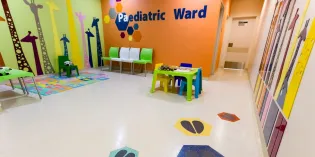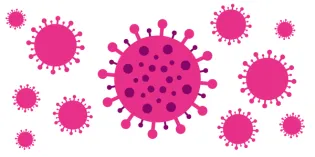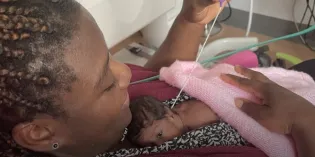We outline a range of good practice ideas that may help and support members tackling these issues this winter.

Introduction
Providing urgent and emergency care for children and young people over the winter was often demanding even before public health measures to prevent the transmission of COVID-19 were introduced. Meeting requirements for social distancing and coronavirus infection control this winter means thinking differently about delivering urgent and emergency care to children and young people.
While the nature of the challenges faced by services may be specific to each local area and require local solutions, many of the pressures expected over this winter are common to themes in the Facing the Future standards for children in emergency care settings. The standards aim to ensure that urgent and emergency care is fully integrated and that children are seen by the right people, at the right place and in the right setting. The themes discussed below have been identified through consultation with PEM clinicians as the key areas that will need to adapt this winter.
On this page, we outline a range of good practice ideas that may help and support members tackling these issues this winter. Some may be implemented relatively swiftly, some will require working across systems and organisations, but all are focused on meeting the urgent and emergency care needs of children and young people.
Get in touch
If you would like to discuss any of the ideas featured below, or if you have examples of innovative models of practice that have been adopted by your emergency department, please contact: health.policy@rcpch.ac.uk.
The care environment
Wherever urgent and emergency care is being delivered, all settings accepting children and young people should be designed to accommodate their needs and those of families and carers accompanying them. The Facing the Future standards for children in emergency care settings describe how this can be achieved.
During the COVID-19 pandemic, many paediatric emergency departments have been temporarily relocated from their usual settings. It is essential that the Facing the Future standards are adhered to wherever this happens.
Further, children’s care in EDs must not be jeopardised by escalation plans and surge policies when pressure builds. Our 2019 position statement on winter pressures in children’s emergency care calls for a system-wide approach that focuses on the specific and particular needs of children and young people and does not allow their healthcare to be overlooked.
Other approaches to accommodating the needs of CYP are small steps such as those to make PPE less scary for children and young people. Some examples include:
- “Supersuits” by Katie Chappell
- "Smile behind the mask" by Dani Hall on Don't Forget the Bubbles - this article describes some other approaches
Patient flow
With the additional demands of demands of social distancing and other infection control measures, some measures that are being explored to support patient flow in emergency departments include:
- Adopting standard operating procedures that allow for nurse led discharge in defined circumstances - a collation of proformas and Standard Operating Protocols to aid flow in Emergency Departments and Assessment Unit are available from Don't Forget the Bubbles (Google Drive)
- Conducting virtual or remote consultations for those usually called back for a planned review in ED, or using other locations
- Using an additional ambulatory consultant, to conduct telephone reviews and provide senior decision-making support
- Helping to alleviate pressure on adult emergency care by treating 16 and 17 year olds in the paediatric emergency department
- Working with hospital specialities to manage direct attendance and admission to surgery, inpatients, and with other services such as community mental health assessment and minor injuries
- Working with inpatient teams to improve ‘pull’ up from the department (while aware of bed losses among inpatient departments due to social distancing)
- Planning for safe transfers between departments and between sites so that PPE requirements are met before during and after transfers
Also, in 2019 RCPCH published a range of examples from members that describe a variety of responses to the issues posed by increased attendances in emergency departments over the winter.
Working with others across the wider system
Working across services to reduce demand for emergency care could help to manage flow into the emergency department. A range of options are being explored with the aim of reducing demand for emergency care from those children who attend more frequently, such as:
- Joint working with local hospital @ home teams, so nurses can deliver ‘ED care’ at home
- Developing education packages for children with long term illnesses highlighting pathways to access appropriate care when unwell
- Working with health visitors and GPs to provide education packages to families with young children who are frequent ED attenders
- Placing consultant paediatricians in GP hubs in the community
- Providing remote access to specialist advice (for parents/carers and for GPs) to avoid delayed presentations of CYP needing urgent care
- Local public information campaigns on when and where to seek help.
Mental health
The effect of lockdown and other public health measures adopted to deal with the pandemic has been significant for many children and young people’s mental health, and this is emerging as one of the key challenges of COVID-19. Emergency care settings often represent the first point of contact for vulnerable children who are seeking help in a crisis, and children can present for a range of reasons. Some practice ideas include:
- Working with local CAMHS and central mental health hubs to manage patient flow in EDs, through risk assessment and referral of low risk patients to central mental health hubs for assessment
- Developing resource packs for all CYP attending with mental health issues, signposting to further information and resources
You can also find Government advice on supporting children and young people’s mental health and wellbeing.
Safeguarding
While this winter may require different ways of working in some respects, it is essential to remain vigilant around enduring aspects of emergency care, such as safeguarding. Concerns have been expressed about the impact of school closures on children and emergency departments may be the first point at which children who have been subject to abuse or neglect meet a health professional.
It is crucial that all staff in emergency and urgent care settings can identify CYP who are or may be at risk of abuse or neglect. There should be clear protocols, relevant and specific to each unit, on what to do when abuse or neglect is suspected. More information is available in Facing the Future standards for children in emergency care settings.
Workforce and training
The importance of a trained and competent workforce runs throughout the Facing the Future standards, as a means of delivering safe and effective emergency care. Promoting access to virtual learning events – webinars, training programmes, etc. - on a local, regional and national level as can all help to meet the training needs identified in the standards, alongside workforce planning that enables and encourages continued access to relevant education and training.
Other resources and information sources relevant to emergency care this winter
- RCPCH wellbeing hub - a collection of useful resources highlighted or created by our members
- Reimagining the future of paediatric care post-COVID-19 - our report from the Paediatrics 2040 programme summarises what has been learned from this period of rapid change, focusing on those aspects of new practice that we can usefully keep and apply into the future
- COVID-19 &Us - RCPCH &Us is working with young people to reflect on their experiences of COVID-19 and the lockdown
- QI Central – our sharing quality improvement sharing hub provided details of some COVID-19 initiatives - for example, virtual consultations, workforce reconfiguration and service development
- Facing the Future standards for children in emergency care settings - our standards set the benchmark for urgent and emergency care for children and young people, and provide help, advice and good practice across a range of themes
- Royal College of Emergency Medicine have best practice guidance (PDF) on ED infection prevention and control during the coronavirus pandemic










